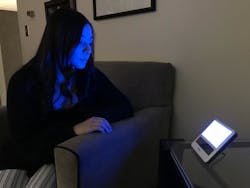Blue light exposure could help heal mild traumatic brain injury
In a newly published study, a team of researchers at the University of Arizona (Tucson, AZ) has shown that early morning blue light exposure therapy can aid the healing process of people impacted by mild traumatic brain injury.
"Daily exposure to blue wavelength light each morning helps to re-entrain the circadian rhythm so that people get better, more regular sleep. This is likely true for everybody, but we recently demonstrated it in people recovering from mild traumatic brain injury, or mTBI. That improvement in sleep was translated into improvements in cognitive function, reduced daytime sleepiness, and actual brain repair," says William D. "Scott" Killgore, psychiatry professor in the College of Medicine – Tucson and lead author of the study.
mTBIs, or concussions, are often the result of falls, fights, car accidents, and sports participation. Among other threats, military personnel can also experience mTBI from exposure to explosive blasts: Shockwaves strike the soft tissue of the gut and push a burst of pressure into the brain, causing microscopic damage to blood vessels and brain tissue, Killgore says.
Those with a concussion or mTBI can momentarily see stars, become disoriented, or even briefly lose consciousness following the injury. However, loss of consciousness doesn't always happen and many people who sustain a concussion are able to walk it off without realizing they have a mild brain injury, according to Killgore. Headaches, attention problems, and mental fogginess are commonly reported after head injuries and can persist for weeks or months for some people. In addition, about 50% of people with mTBI also complain that they have sleep problems after an injury, Killgore says.
Recent research has shown that the brain repairs itself during sleep, so Killgore and his co-authors—John Vanuk, Bradley Shane, Mareen Weber, and Sahil Bajaj, all from the Department of Psychiatry—sought to determine if improved sleep led to a faster recovery.
In a randomized clinical trial, adults with mTBI used a cube-like device that shines bright blue light (with a peak wavelength of 469 nm) at participants from their desk or tables for 30 minutes early each morning for six weeks. Control groups were exposed to bright amber light.
"Blue light suppresses brain production of a chemical called melatonin," Killgore says. "You don't want melatonin in the morning because it makes you drowsy and prepares the brain to sleep. When you are exposed to blue light in the morning, it shifts your brain's biological clock so that in the evening, your melatonin will kick in earlier and help you to fall asleep and stay asleep."
As a result of the blue light treatment, participants fell asleep and woke an average of one hour earlier than before the trial and were less sleepy during the daytime. Participants improved their speed and efficiency in brain processing and showed an increase in volume in the pulvinar nucleus, an area of the brain responsible for visual attention. Neural connections and communication flow between the pulvinar nucleus and other parts of the brain that drive alertness and cognition were also strengthened.
Killgore and his team plan to continue their research to see if blue light improves sleep quality and how light therapy might affect emotional and psychiatric disorders. Killgore believes that most people, whether injured or healthy, could benefit from correctly timed morning blue light exposure, a theory he hopes to prove for certain in future studies.
The U.S. Army Medical Research and Development Command funded the research.
Full details of the work appear in the journal Neurobiology of Disease.
Got biophotonics-related news to share with us? Contact Lee Dubay, Associate Editor, BioOptics World
Get even more news like this delivered right to your inbox
